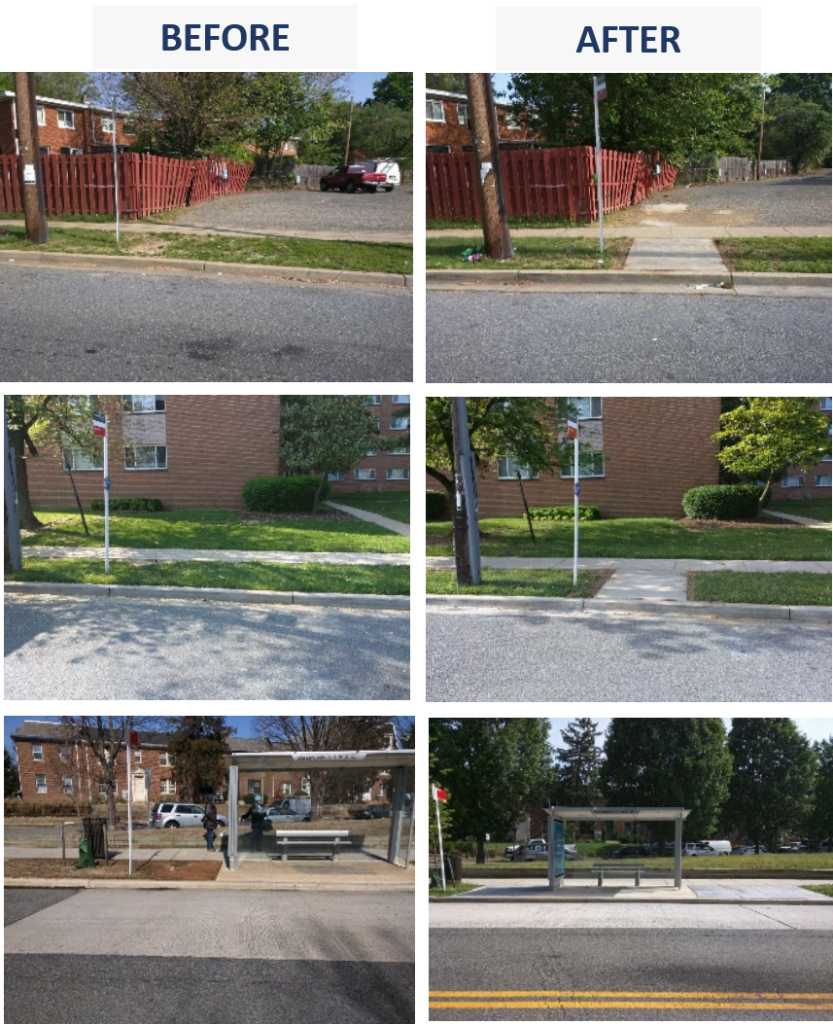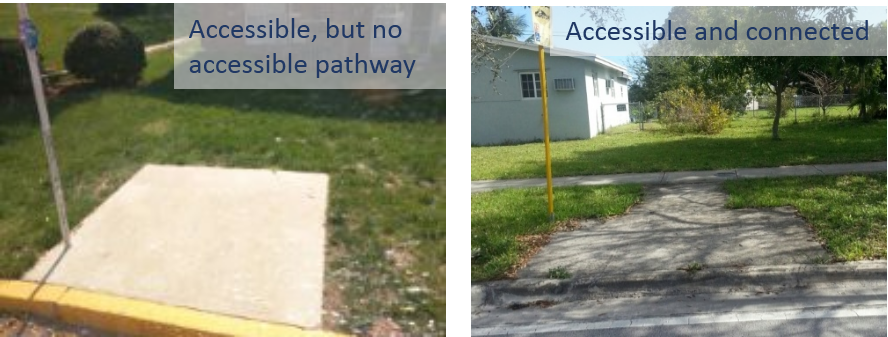Bus Stop Accessibility Improvements – Making Good on the Promise of the Americans with Disabilities Act
Metro is taking a data-driven approach to make the region’s bus stops more accessible to all.
The signing of the Americans with Disabilities Act (ADA) on July 26, 1990 was a landmark event in our nation’s history. Like other pieces of civil rights legislation, this law works to ensure a more inclusive America, one where every person has the right to participate in all sectors of society and be recognized for his or her accomplishments. Its passage paved the way for millions of Americans with disabilities to positively contribute to their communities in a variety of ways, including employment.
Two decades on, however, much work still remains to be done.
The DC region has over 19,000 bus stops, with approximately 11,100 served by Metrobus, and the remaining 8,900 served exclusively by locally operated transit systems. Of the 19,000 stops, approximately 6,500 are inaccessible to some people with disabilities. Inaccessible bus stops can be a reason for an individual to qualify for MetroAccess paratransit service operated by Metro, and can be a reason for an individual to choose MetroAccess over fixed route bus service for a particular trip. Accessible bus stops reduce demand for paratransit service, and improve safety for all customers. Metro and each jurisdiction in the region are working to improve inaccessible stops. In addition to improving stops Metro also aims to use an array of data as well as policy adjustments to strategically target bus stops for improvements.
Metro’s Bus Stop Standard
Metro maintains a database of the region’s bus stops. As a result of a new bus stop standard, Metro is not only updating the information in the database, but is working to improve the database in two significant ways: 1) provide jurisdictional access to update the database and 2) the addition of a smartphone app.
The standard criteria of an accessible bus stop includes the following: 1) Flat and Firm Surface, 2) 5 feet wide x 8 feet long, and 3) Connects to the Curb. Metro has added a fourth criterion for measuring the accessibility of a bus stop: the presence of an accessible pathway to/from the nearest corner to the bus stop. That accessible pathway must include a curb cut at the corner with an additional curb cut at one adjacent corner.
The two photos above illustrate the difference. Both bus stops feature flat and firm surfaces that are at least 5’ x 8’ in size, and both connect to the curb. So under the standard criteria, both are accessible bus stops. The difference is that the stop in the photo on the left is surrounded by grass and dirt. There is no accessible pathway to/from the stop. The stop on the right connects to the accessible sidewalk and pathway to the corner.
Bus Stop Database and Smartphone App
Metro is working to improve its existing Bus Stop database in two significant ways: 1) provide jurisdictional access to update the database and 2) the addition of a smartphone app, currently in development.
Recognizing that the jurisdictions have more up-to-date information, Metro is developing a system that will allow the database to be updated directly by the jurisdictions. Once completed, Metro will deploy this system, and it will provide an improved process for collecting and tracking robust and accurate bus stop data, and help facilitate more efficient regional bus stop management decisions.
The community smartphone app will provide the general public with information on the accessibility of each stop in the region, and allow the public access to comment on the accuracy of the database representation of the stops. This community approach will help Metro and our regional partners maintain the most up-to-date status on each stop, which helps keep the traveling public well informed.
Work is Underway!
While improvements to the database and the development of the app continue, bus stop accessibility improvements continue. Below are pictures of recently completed projects:

top to bottom: Keith Street and St. Clair Drive, eastbound & westbound (Prince George’s County), and Massachusetts Avenue and 18th Street, SE (Washington, DC)
Let us know in the comments if you know of any bus stops that are challenging for persons with disabilities to use.



The bus stop at Potomac Ave SE and Kentucky Ave SE (for southbound B2 buses) is not accessible (difficult even for able-bodied passengers). Thanks!
A number of Arlington bus stops (including 6000213 and 6000198, to name two that I have used recently) have nearby sidewalks as accessible pathways but do not have flat and firm surfaces for boarding and disembarking — just the grass curb strip. In wet weather, it is particularly difficult to know if stepping off the bus at these stops might mean slipping on soaked grass or losing a shoe in the mud. I have seen drivers let passengers off onto the street because the grass curb strips aren’t stable surfaces. If I had a cane or crutches, I’d hate to have to get off at a less-convenient stop because I couldn’t trust the one closest to my destination.
Are the first two in the before/after pictures really 5′ x 8′?
@MLD
Yes. Each is 5′ wide.
Why not start with having less bus stops. Every time I get on a WMATA bus it seems to stop every 300ft, every block, making for an excruciatingly slow ride. Why not put the stops further apart, say 1200ft apart so the bus can get up some speed and get people where they want to go at a reasonable pace.
Then make those bus stations more accessible.
@Richard
We agree. Metro has a bus stop consolidation effort already underway. More than 100 stops have already been consolidated througout the region.
@slg
Hello,
Stop 6000213 is actually slated for consolidation due to low ridership and presence of a nearby ADA-compliant stop with shelter at 13th Road S. We will definitely work with WMATA and reach out to riders before consolidating this stop, but the current plan is to remove it with a future streetscape improvement project that is currently in design.
Stop 6000198 is on a list of stops to be improved in 2016. Planned improvements will consist of an ADA compliant boarding area and a freestanding bench.
Thank you,
Arlington County Bus Stop Coordinator
This kind of game gives a real experience of building a farm and planting gedfkgefdafd